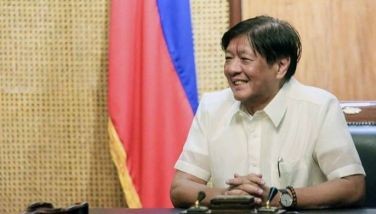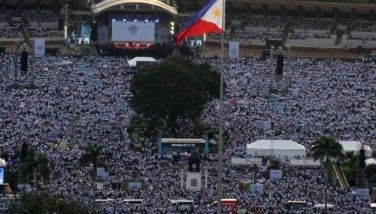Laurel-Langley trade agreement and reparations from Japan – Magsaysay presidency (2)


During Magsaysay’s presidency, the country concluded two agreements with important economic consequences for the future.
The first was with the United States (to revise our economic adjustment program after independence) and the second, with Japan (to agree on war reparations as prelude to normalization of peace-time political relations.)
Revised Phl-US trade agreement, or the Laurel-Langley agreement. The US Congress passed in 1946 a law called the Philippine Trade Act. More popularly known as the Bell Trade Act, after its principal author the senator from Missouri, this US law spelled out the trade and economic relations of the United States with the newly independent Philippine republic.
A US- appointed Joint Commission of American and Philippine Commonwealth officials studied the future economic adjustment of the prospective Philippine independent republic. The recommendations of the study were made a basis of the adjustment law, lengthening, however, the period of adjustment because of the ruined state of the Philippine economy after the war.
A separate law to assist economic rehabilitation from the war destruction for the new republic was passed. This involved the appropriation of a total of $520 million of war damage compensation, of which $120 million to rebuild destroyed public properties and $400 million as compensation for private property damage. This was a very large sum of economic aid at the time.
To accept the provisions of the Philippine Trade Act would mean that the young republic would conclude its first major economic treaty with a foreign power! This event, however, did not come easy politically.
The trade law provided that Americans be accorded equal rights with Filipino citizens. But after political independence, all non-Filipino citizens became foreigners, including Americans. This was the “parity” rights issue.
Under the 1935 constitution, three areas of economic activities were reserved to Filipino citizens and corporations: ownership of land, operation of public utilities, and exploitation of natural resources.
The newly-elected Philippine Congress was put in turmoil soon after independence. The Congress tried to amend the constitution but could not fully muster the required three-fourths vote to amend. It did so only by expelling some members that opposed it from the chamber. This led to a constitutional challenge in the Supreme Court.
The remedy, therefore, was to have a national referendum on the question. After campaigning hard for the amendment, the government secured a comfortable margin to amend the constitution, with 79 percent of votes.
That was on March, 1947. Though the constitution was amended, the stain on national sovereignty had been planted. Some leaders felt that the newly independent nation was humbled at a time of great weakness.
And then there was also the provision in the independence act that the peso exchange rate could not be changed without the approval of the US president. Such control by a foreign power of the nation’s currency was inconsistent with independence.
When Magsaysay became president, he listened to these important issues and pressed for change. When he secured the US president Dwight Eisenhower’s consent to renegotiate, Magsaysay asked senator Jose Laurel to head the Philippine panel. An era of new goodwill was in the offing.
Under the Laurel-Langley Agreement, the US acceded to the removal of the provision that the peso exchange rate be subject to American approval. But the US did not back down on the matter of parity rights, leaving that to the interpretation of the courts.
We must note that in international diplomatic practice, “national treatment” is granted to foreign investors. So, the issue was not really a big deal, except in the Philippines. If only the Philippine constitution did not have such provisions to begin with and had local laws to deal with foreign investments, the matter would not have arisen.
Many other provisions of the economic relations improved with the conclusion of the Laurel-Langley agreement. US control of the peso exchange rate was removed. The US did not yield its position on parity rights, left the matter to be interpreted in Philippine courts.
The schedule for preferential tariff rates for Philippine exports to the US were improved while those for US imports into the Philippines remained the same under the same schedule of preferences. The previous tariff preferential discounts were uniform percentages for both US and Philippine tariff rates.
Many issues pertaining to US import quotas on Philippine exports to the US were adjusted toward mutual satisfaction.
Japanese reparations as prelude to normalization. Ramon Magsaysay’s presidency would make it possible to conclude the normalization of relations with Japan, sooner rather than later.
When most countries concluded the peace treaty with Japan in 1951, the Philippines held its reservations pending resolution of other issues, including reparations.
By making it sooner, the benefits of helping Japan also normalize its relations with neighbors would help that country play a more positive regional role sooner.
In the case of the Philippines, getting the reparations questions settled first opened the way for later future relations in which Japan’s foreign development assistance could play a critical role in helping to meet the nation’s growing development needs – beyond reparations and along channels of trade, investment, and development assistance.
In May 1955, the Philippines concluded the reparations agreement with Japan. The agreement provided for the payment of the dollar equivalent of $550 million. Separately, there was promised loans to the private sector amounting to $250 million on a commercial basis.
The country could have played a long waiting game by demanding large reparations. But by committing to a level that was deemed feasible for Japan to pay at the time, Magsaysay made it possible for the former enemy to play a more positive and normal role as a peacetime partner in development.
This strategy worked well. Japan became by the 1970s, the largest trading partner and also the largest source of economic development assistance to the country.
My email is: [email protected]. For archives of previous Crossroads essays, go to: https://www.philstar.com/authors/1336383/gerardo-p-sicat. Visit this site for more information, feedback and commentary: http://econ.upd.edu.ph/gpsicat/
- Latest
- Trending




























